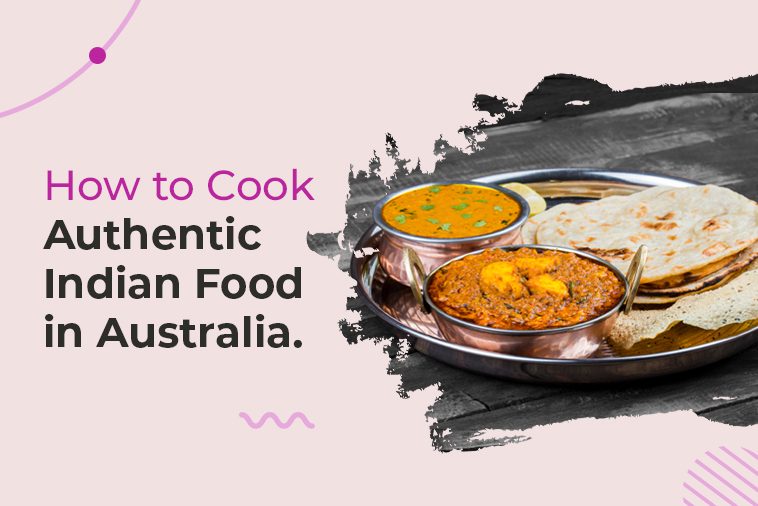If you’re Indian and you live in Australia, you could find that the tantalising fragrances and flavours of traditional home-cooked Indian food are something you miss from time to time. If this is the case, Australia might not be the best place for you.
The good news is that it is definitely possible to cook authentic Indian food in Australia, and this is made possible by the extensive availability of Indian ingredients at supermarkets and other retail outlets all throughout the country.
In this instructional guide, we will go over some of the most crucial concepts and methods that will be of assistance to you in the process of cooking scrumptious Indian cuisine in the comfort of your own home.
Also Read : 5 Best Indian Jewellery Store In Brisbane
Stock up on Authentic Indian Spices:
As was just discussed, the distinctive flavours of Indian cuisine are mostly accomplished by the liberal application of various spices. Cumin, coriander, turmeric, cardamom, cinnamon, and cloves are all typical spices found in Indian cuisine and are used in a variety of dishes. You should be able to get these in most supermarkets, but if you want a more extensive range, you should look for them in an Indian supermarket.
To get the most out of whole spices, you should first roast them in a dry pan before grinding them up. This will allow their full flavour to come out. When the pan is hot, turn the heat up to medium-high and add the whole spices.
Stir the mixture regularly while it cooks so that the spices can become fragrant and gently browned. Take the mixture away from the flame and wait until it has cooled before crushing it in a spice grinder.
Invest in a Spice Grinder:
It is strongly suggested that a spice grinder be acquired as soon as feasible.
For both the actual grinding of spices and the formulation of one’s own one-of-a-kind spice combinations, a spice grinder is an essential piece of kitchen equipment that is necessary to be used.
The operation at hand can be accomplished with either a portable electric coffee grinder or a mortar and pestle, the latter of which requires more physical labour but yields superior results. Both of these solutions are valid alternatives.
Use Ghee Instead of Oil:
Ghee, also known as clarified butter, is an essential component in Indian cuisine. It imparts a robust, buttery flavour to the foods that are prepared with it. You can find ghee in the dairy section of most supermarkets, or you may make your own by melting butter and removing the milk particles.
To prepare ghee for use in cooking, melt it in a skillet over medium-high heat until it is liquid and then set it aside to cool. Sauté onions and garlic in it before adding other ingredients, or use it to toast whole spices for tempering.
Experiment With Different Types of Lentils:
Lentils are an absolute game-changer in Indian cuisine! Lentils come in a wide variety of shapes, sizes, colours, and colours, and each has its own unique flavour and texture. Some of the most common lentils in Indian cooking include moong dal, toor dal, and chana dal.
Lentils require a good cleaning and a few hours of soaking time before they can be cooked. Cooking instructions: After draining, add in a saucepan with water or broth and any desired spices (such as turmeric or cumin). Simmer the meat, checking on it occasionally, and adding more liquid if required, until it is tender.
Don’t Shrink From The Fire:
The amount of spiciness in Indian cuisine may typically be adjusted to fit the preferences of the diner. If you’re not used to eating food that’s really spicy, start with a little amount of chilli powder or fresh chilli and add more as you feel comfortable with the heat.
Make Use of Fresh Herbs:
Indian cuisine is known for its liberal use of fresh herbs as flavouring, particularly cilantro, mint, and other similar herbs. This is because the meal has a taste that is both energising and revitalising from the fresh herbs that are used.
This is due to the fact that each and every dish in Indian cuisine lays a significant emphasis on the utilisation of fresh ingredients.
When using fresh herbs, they should first be washed, and then after that, they should be chopped very finely before being added to recipes at the very end of the process of cooking. This assures that their flavour will not be altered in any way.
Make Your Own Spice Blends:
It is simple to create your own spice mixes, and doing so gives you the ability to tailor the flavours to your preferences. Garam masala and chaat masala are two examples of popular spice mixtures that are utilised in Indian cookery.
To prepare garam masala, first roast entire spices such as cumin, coriander, cardamom, cinnamon, and cloves on a dry pan until the spices release their aroma. To keep the toasted spices fresh, combine them with some powdered nutmeg in a spice grinder and store the mixture in an airtight container.
Cumin, coriander, fennel, and ajwain seeds, together with amchur powder (dried mango powder), black salt, and red chilli powder, should be ground together in a spice grinder to prepare chaat masala.
Master the Art of Tempering:
In Indian cuisine, a method known as tempering, often referred to as tadka, is used to bring out the full flavour of entire spices. To temper, heat a tiny amount of oil or ghee in a pan over medium-high heat in the small pan.
Fry entire spices like cumin, mustard seeds, or curry leaves until they release their aroma, and then set the dish aside. Just before serving, drizzle the dish with the spice mixture that has been tempered.
Use Yogurt For a Creamy Texture:
Adding a creamier texture to Indian foods like curries and marinades sometimes requires the use of yoghurt, which is a common component in the cuisine of that country. Yoghurt is frequently utilised in the food industry as a flavour ingredient.
If you want a dish that is tender and flavorful, consider marinating the chicken or lamb in yoghurt that has been combined with a variety of spices. This will provide the desired results.
Some Popular Indian Dishes that You Can Try Making at Home Using the Above Tips and Techniques Include:
• Aloo Gobi
• Chana Masala
• Butter Chicken
• Palak Paneer
• Samosas
CONCLUSION:
To summarise, preparing real Indian cuisine in Australia is not nearly as challenging as it would first appear to be. The outcome is going to be well worth the time and effort that it takes to track down the appropriate components and educate oneself on the appropriate procedures.
You can easily reproduce the mouthwatering flavours and heady fragrances of Indian food in your own home kitchen by adhering to a few straightforward recipes and playing around with a variety of spices and seasonings.
There are many real Indian cuisines available, so whether you’re in the mood for a dish that’s rich and creamy like Butter Chicken, spicy and sour like Chana Masala, or hearty and savoury like Aloo Gobi, you’ll have plenty of options to pick from.
Why not give Indian cooking a go today and treat yourself to a dish that reminds you of home even if you’re not there?




GIPHY App Key not set. Please check settings